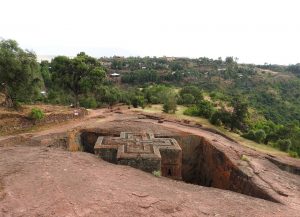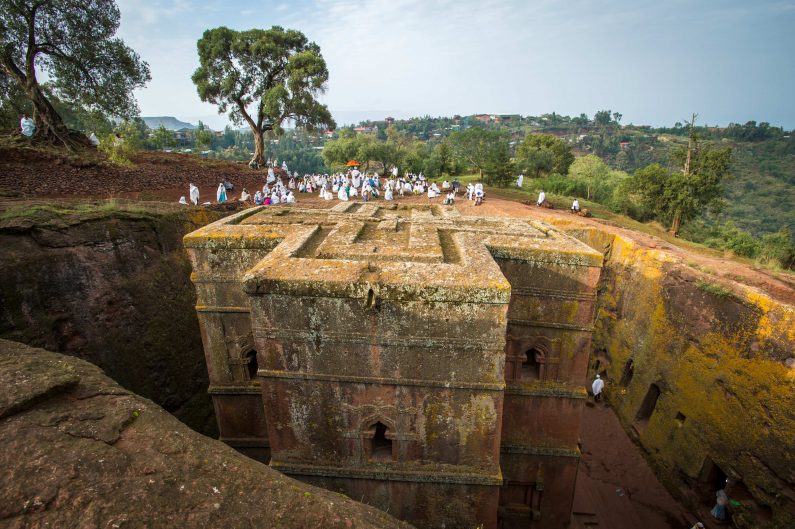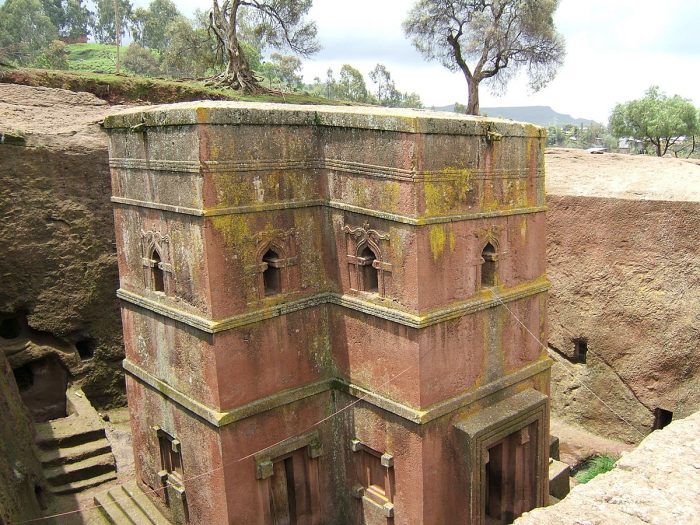What pops into your mind when you hear “Ethiopia”? The rock-strewn, pink to red churches? Most people who visit Ethiopia seek to see these fascinating churches of Lalibela, and it is not a surprise why.
Here’s everything you need to know about Lalibela…
Lalibela, Ethiopia
Lalibela is a high place of Ethiopian Christianity. It is a small rural town of 35,000 people located about 645 kilometers from Addis Ababa, set in a stunning mountainous region. According to legends, King Lalibela was set out to construct the “New Jerusalem” of the 12th century after Muslim conquests stopped Christian pilgrimages to the Holy Land. So, angels and men worked together to build monolithic churches carved out of rock.
Surrounding the churches is a traditional village with circular-shaped dwellings, constructed of local red stone, and known as the Lasta Tukuls. Camels and horses can be seen around as this is the primary mode of transportation. Truly, going to Lalibela is like being transported to an ancient world.
How to get here
To get to Lalibela, the best places to start your journey from are either from Ethiopia’s capital, Addis Ababa, or from Mekele, a town in the north of the country.
- By air: You can fly to Lalibela Airport (LLI) via Ethiopian Airlines which has scheduled flights everyday. Note that Lalibela Airport (LLI) is about 30-60 minutes drive to town and you can either have your hotel pick you up, hire a cab (you can also opt to share a taxi with other travelers, if you want) or take a minibus. When you get to the town of Lalibela, though, expect to see horses pulling cart or some camels. Minibuses and cars are not common in town, although some people rent minibuses to drive them around.
- By road: From Addis Ababa, you can take a 2-day bus trip to Lalibela, passing through Woldia and making an overnight stop at Dessie. Buses usually depart at 6am (as of, July 2019). If you come from Bahir Dar, the bus trip ( or even private car journey) would only take one day (approximately 7-8 hours), changing buses at Gashena, a village 1 to 2 hours away from Lalibela. If you start at Gondar, travel time to Lalibela is usually about 11 to 12 hours.

The Jerusalem of Ethiopia
Considered one of the holiest places on Earth, Lalibela is often regarded to as “The Jerusalem of Ethiopia.” Being home to one of the oldest Christian churches in the world which dates back to the early fourth century, Lalibela brims with spirituality and in fact still remains a place of devotion and pilgrimage up to this date.
Lalibela is made up of 11 medieval monolithic cave churches. “Cave churches” because unique from all other churches in the world, Lalibela churches are built from the top down. They were chiseled out to form windows, doors, columns, roofs, ceremonial passages, and even openings to hermit caves and catacombs.
The 11 churches of Lalibela are grouped into 2 main groups with one being isolated from the others:
- The north of the river Jordan:
- Biete Medhani Alem (House of the Savior of the World): believed to be the largest monolithic church in the world
- Biete Mariam (House of Mary)
- Biete Maskal (House of the Cross)
- Biete Denagel (House of Virgins)
- Biete Golgotha Mikael (House of Golgotha Mikael)
- The south of the river Jordan:
- Biete Amanuel (House of Emmanuel)
- Biete Qeddus Mercoreus (House of St. Mercoreos): believed to be a former royal residence
- Biete Abba Libanos (House of Abbot Libanos)
- Biete Gabriel Raphael (House of Gabriel Raphael): also believed to be a former royal residence
- Biete Lehem (House of Holy Bread)
- Biete Ghiorgis (House of St. George): the eleventh church which is isolated from the others but connected by a system of trenches; very famous for its remarkable cruciform plan.

UNESCO World Heritage Site
It is no wonder why these amazing Lalibela churches are recognized a World Heritage Site by UNESCO, thanks to its unique features, strong history and considerable influence. It has been incredibly preserved in its natural settings, and has been deemed an excellent substitute for the holy places of Jerusalem and Bethlehem. Due to its unique features and intriguing history, not to mentions its fine vista composed of stunning mountain views, it is often called the “eighth wonder of the world”.
Why visit Lalibela?
✓ A bucket-list experience: Aside from visiting a world-famous UNESCO heritage site, where else can you see a cluster of pink monolithic churches?
✓ The people: Ethiopians are some of the most welcoming and generous people in the world. They are, after all, in a holy land, right?
✓ Fantastic photo opportunities: Natural backdrops, unique churches and a beautiful sunshine that serves as natural lighting – totally Instagram-worthy!
✓ Deeply rooted culture and history: Just reading about its history is fascinating enough. What more if you see it in person?
Best time to visit
For many people, the best time to visit Ethiopia is during the dry season, which runs from October through February. If dry weather is what you’re after, December to February are the driest months in which chance of rain is extremely low.
However, if you are after Lalibela’s cultural festivals. Some of these festivals are held during rainy season like the Enkutatash or Ethiopian New Year and the Fasika or Easter.
Also, the least humid month is June while the most humid month is August.
A fascinating trip!
It is most certainly a sacrilege to miss Lalibela during any visit to Ethiopia. The place is impeccable – from the breathtaking natural vista to the rock-hewn churches to the unforgettable vibe of being taken to an ancient city.










